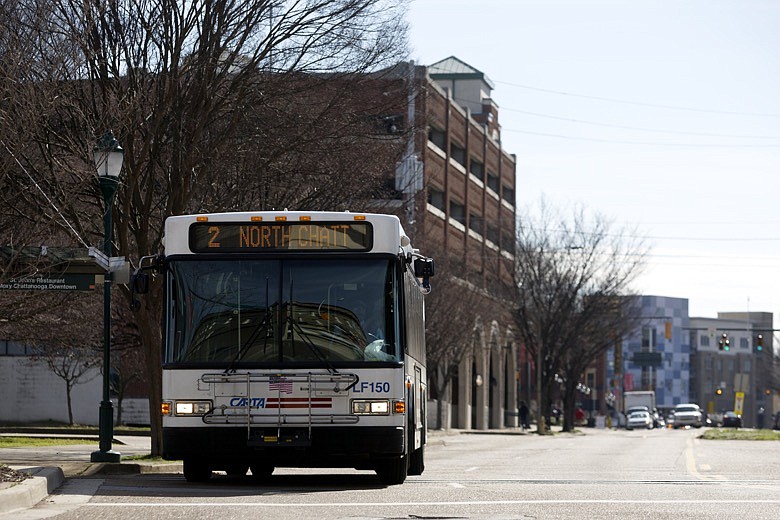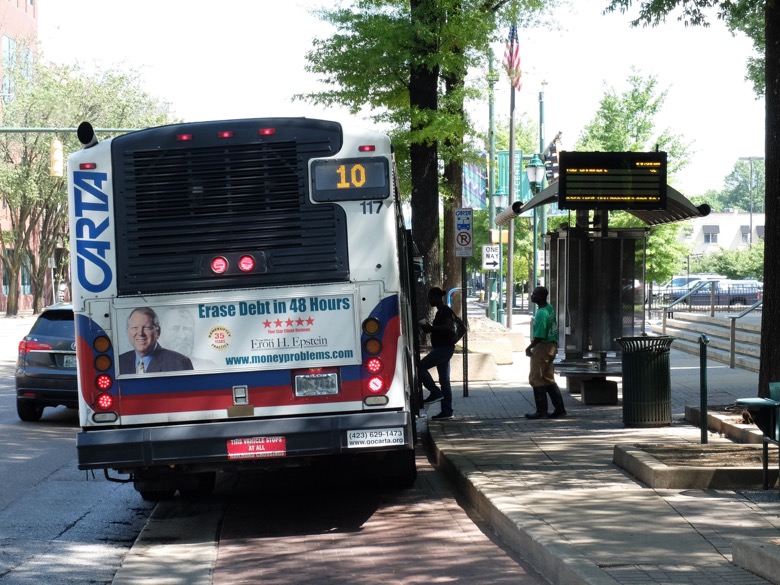As it looks to redesign the city's bus routes, the Chattanooga Area Regional Transportation Authority plans to focus on boosting ridership numbers by compromising on coverage.
A draft of the redesign plan, which has been in the works since 2018, was presented at Thursday morning's CARTA board meeting. It reflects the board's plan to expand the number of riders using Chattanooga's bus and electric shuttle system with a "modest" operational investment, rather than focusing on expanding geographical coverage.
"We've been through a long process of helping [CARTA] with the somewhat challenging question of how much to focus on ridership and how much to focus on coverage. As with any community facing this question, it is a tough trade-off," said Scudder Wagg, a consultant with Jarrett Walker and Associates, the transit design firm working with CARTA on creating a short-term and long-term redesign plan, in an update to the CARTA board on Thursday.
"Everyone wants to increase frequency so we can increase ridership and get all of the green benefits associated with that, and to support urban development - but in doing that you might lose coverage in places that are further outfield where there might be a very dire need for transportation," Wagg added.
The plan focuses on maintaining current coverage, but reorganizing routes and frequencies to foster higher ridership in the existing coverage area in the short term. It lays out more "lofty" ridership goals for the city over the next couple of decades.
Increasing ridership
The immediate plan drafted by the design firm details how buses and shuttles could change in the next three years, with minimal operational expenses to lower frequency in low-density areas, eliminate route redundancies and reinvest in ridership-oriented service.
According to Wagg, the proposal would result in about 18,300 additional people being within half a mile of frequent service - defined as service every fifteen minutes - a 184% increase in people with that access, compared to the current system.
"That's a significant increase over today where, outside of the shuttles, you don't really have frequency downtown," Wagg said. "And it would put 17,000 more jobs within half a mile of frequent service, so that's a 58% increase over today. That's a significant increase of people with access to significantly more jobs where they don't have to overthink transportation."
According to Wagg, the new design would allow the average person within the city to access roughly 1,200 jobs within 60 minutes, including walking to and from a bus stop.
"That's a 4% increase in the average person's access to opportunities and jobs," he added, explaining that the increase would not only make work more accessible to riders, but also doctors, shops and other important destinations.
The plan details creating a pulsating "trunk" of service on a 10-minute rotation rolling up and down Broad and Market streets, which would meet redesigned citywide bus routes at a central transportation center in northern downtown to provide more frequent and coordinated service across the routes.
When trying to maintain low-frequency routes, "the hardest part is making connections," Wagg said. "The best way to improve connections in most towns like Chattanooga is to have all of the low-frequency routes meet on a regular schedule in a central location."
Wagg suggests running the longer routes so that they align every 30 minutes at a revamped bus station.
"To best implement this policy direction, and to make this as effective and useful to people as possible, we need a space to bring 8-10 buses together at once for transfers," Wagg said. "This needs to be at a place which is naturally downtown and central to these routes so they can meet all together at the same time once every hour or half hour."
Wagg suggested the board consider renovating the existing Shuttle Park North to create a space for the buses to congregate, drivers to take breaks between routes and to establish a more transit-centric presence downtown.
"It's important not to push this location way to the outskirts of downtown, not only because that will cost time, but I would add that pushing it way outside tells people transportation isn't central to us," he added. "Having this kind of hub downtown shows that Chattanooga is serious about transit."
While Wagg said the renovations could cost "just a few million," a much more cost-effective option than building a new station, CARTA board member Michael Feely said the board should make sure not to cut corners in the renovation.
"It needs to be more than just a fresh coat of paint. I don't know where the money would come from, maybe there's some really great foundation out there, but we should do something beyond making it some innocuous downtown building," Feely said, citing a bus station in Knoxville. "It needs to be some kind of center that says, 'This is an important institution - we value public transportation and we value you for riding."
Wagg's report also glanced at a "more lofty" long-term plan that details a further push for increased ridership over the next 15-20 years. In the long-term plan, Wagg suggests a more than 400% increasein people with frequent service within half a mile and nearly a 140% increase in jobs with the same access.
The long-term plan, however, would require "no less" than a 70% increase in operational expenses to expand routes, frequency and service hours.
Community input
Throughout the summer, CARTA hosted community input meetings to gather direction on the redesign before it was drafted.
In the early stages of community input, many citizens pushed for increasing coverage to ensure equity for all potential riders in Chattanooga.
"Does what you're looking at in these scenarios take into account just pure population or pure jobs, or does it take into account where the population is that needs transportation because they can't afford a car?" community member John Hubbard asked at a June meeting. "Does it take into account the kinds of jobs that those people can get? Do we need transportation for the people who make a hundred grand and have five cars?"
Considering past community input and the anticipated displeasure of citizens in areas where frequency will decrease, according to the draft, CARTA is preparing to explain the proposed changes and gather further community and stakeholder input before the board votes to adopt the plan.
"We already have an appointment with the city council on Tuesday, so we'll be presenting it during their agenda session," CARTA Executive Director Lisa Maragnano said, listing upcoming appointments with other local groups such as the chamber of commerce and visitors bureau. "Once we get through that, we're going to start public input because we don't want the board to vote on something that may change based on public feedback."
Contact Sarah Grace Taylor at staylor@timesfreepress.com or 423-757-6416. Follow her on Twitter @sarahgtaylor.

